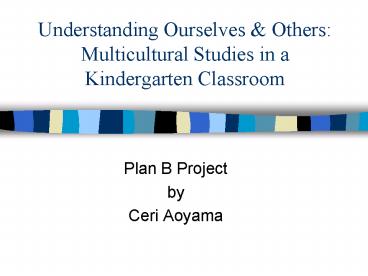Understanding Ourselves - PowerPoint PPT Presentation
1 / 15
Title:
Understanding Ourselves
Description:
This is a great problem of mankind. We have inherited a large house, a great ' ... and Jew, Catholic and Protestant, Moslem and Hindu - a family unduly separated ... – PowerPoint PPT presentation
Number of Views:44
Avg rating:3.0/5.0
Title: Understanding Ourselves
1
Understanding Ourselves Others Multicultural
Studies in a Kindergarten Classroom
- Plan B Project
- by
- Ceri Aoyama
2
This is a great problem of mankind. We have
inherited a large house, a great world house in
which we have to live together - black and white,
Easterner and Westerner, Gentile and Jew,
Catholic and Protestant, Moslem and Hindu - a
family unduly separated in ideas, culture, and
interest, who, because we can never again live
apart, must learn somehow to live with each other
in peace. Martin Luther King, Jr.
3
Significance of study
- The U.S. is one of the most ethnically
culturally diverse nations in the world. - Ethnic minority groups make up 1/3 of student
population. - By the year 2035, half of the U.S. school
population will be made up of minority students.
(School Library Journal, 1993) - Significant impact on the curriculum teaching
practices to accommodate multicultural needs. - Schools can promote knowledge, respect, and
understanding of diversity in student population.
4
Purpose of Study
- Everyone is special and unique.
- Develop positive self-images.
- Create awareness of cultural similarities and
diversity. - Promote the value of respect.
- Foster a caring environment.
- Implement at an early age.
5
Literature Review
- Culture applies to any group with coherent norms
traditions that help members engage the world
around them. It governs how people share
information knowledge, as well as how they
construct meaning. (Oliver, 1992)
6
Multicultural education defined
- Multicultural education incorporates the idea
that all students, regardless of their gender and
social class and their ethnic, racial, or
cultural characteristics, should have an equal
opportunity to learn in school. (Banks, 1989, 3) - To fully participate in our democratic
societyall students need the skills a
multicultural education can give them to
understand others and to thrive in a rapidly
changing diverse world. (Banks, 1992, 35)
7
Description of study
- Implemented a multicultural unit called Families
Are Special. - To introduce different vocabulary.
- To create recognition an awareness about their
own cultural background identity. - Unity Diversity Share about themselves and
learn about others.
8
Research Design
- Informed parents invited them into classroom.
- Survey to parents
- Pre-test
- Implement unit
- Continuous observation assess journey to end
product - Students make a book about their family
- Post-test
9
Families Are Special Unit What is a family?
- Read books about different types of families.
- Made a class web.
- Research by talking with parents filling out
worksheet. - Share their family with the class
- Families Are Special wall
10
(No Transcript)
11
Families Are Special Unit How are families
same different?
- Read books that portrayed families of different
ethnicity culture. - Students researched their ethnic background
familys culture. - Shared and made a matrix.
12
(No Transcript)
13
Families Are Special UnitHow can we
communicate with a family member who does not
live with us?
- Found a family relative who does not live on
Oahu. - Students sent a letter to their relative.
- Relative sent a postcard to school.
- Shared the postcard where the relative lives.
- Mapped where the postcard came from.
14
(No Transcript)
15
Thank you!
- Mahalo! Gunalchéesh hó hó! Ta! Salamat!
Fa'afetai! Terima kasih! - Doh je! Multumesc! Danke! Grazie!
Kamsahamnida! Dakujem! Vinaka! - Merci beaucoup! Khawp khun! Cheers!































